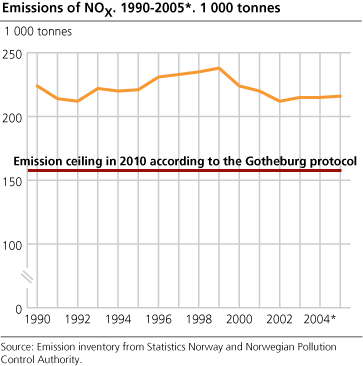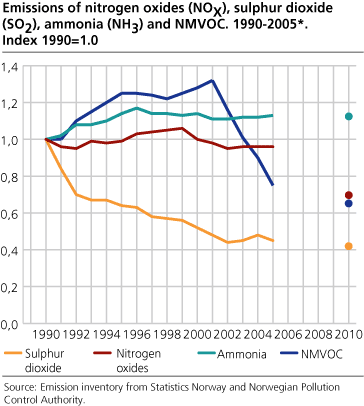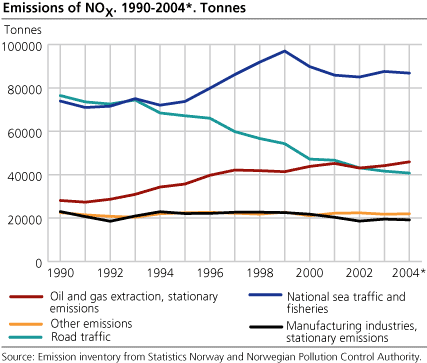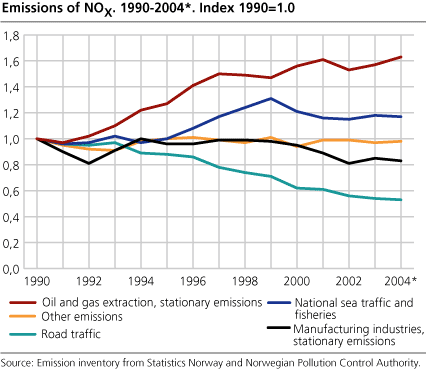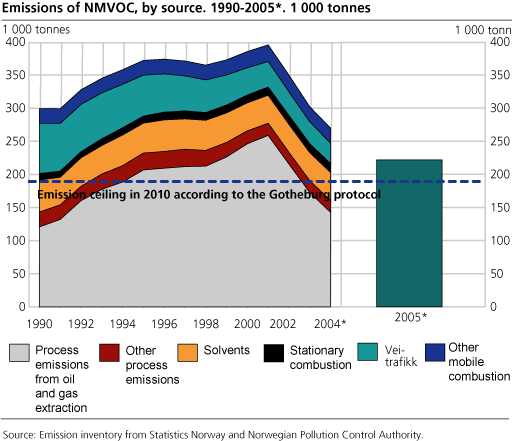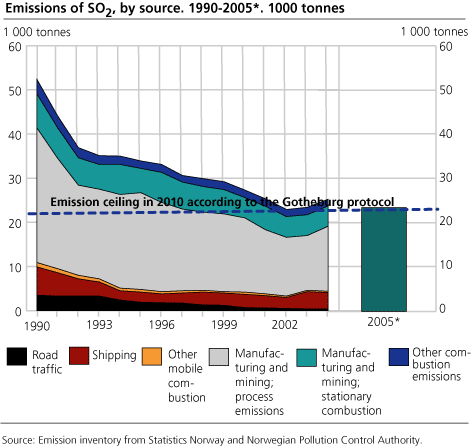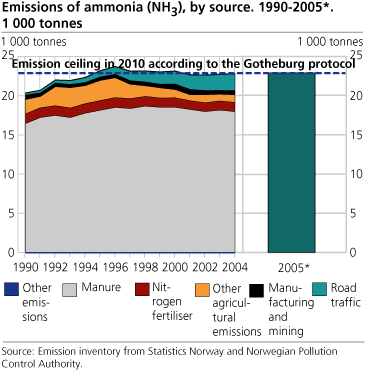Content
Published:
This is an archived release.
Considerable NOX reductions necessary
The Gothenburg Protocol, which entered into force in 2005, sets a limit for emissions of four gases in 2010. Norway is far away from fulfilling its commitments for nitrogen oxides. For sulphur dioxide and NMVOC, there has been a significant decrease in 2005. The ammonia emissions continue to be just below the target.
Norway has not reduced the emissions of nitrogen oxides considerably since 1990. This is shown in preliminary calculations from Statistics Norway and the Norwegian Pollution Control Authority. Through the Gothenburg Protocol, which came into force in 2005, Norway is committed to keep the emissions in 2010 below 156 000 tonnes. In 2005, however, the emissions were almost 216 000 tonnes, which is 1 000 tonnes more than in 2004 and 38 per cent higher than the demanded level in the Protocol. This means that the emissions must be reduced by 60 000 tonnes, or 12 000 tonnes per year, in the period 2006-2010.
Domestic shipping may be the main problem
We have to wait until early 2007 to see the final 2005 figures distributed by source. But now, the most important reason for the increase seems to be higher emissions from domestic shipping and fishing. The uncertainty in these calculations is high, but the sales statistics for petroleum products show increased sales to these industries. Emission reductions from some processes in the manufacturing industries and from petrol cars contributed to limit the growth in total NOx emissions.
NOx emissions have been reduced by 4 per cent from 1990 to 2005. Increased emissions from oil and gas activities and domestic shipping and fishing have limited the emission reduction. In 1990, road traffic was the most important source of NOx emissions, and contributed to 34 per cent of the emissions in Norway. Because of cleansing technology in new cars after 1990 (catalytic convertors), road traffic emissions have decreased to a share of 19 per cent in 2004, despite increased activity in road traffic.
Domestic sea transport and fishing was the largest source for NOx emissions in 2004 and contributed to 40 per cent of the total, compared to 33 per cent in 1990.
NMVOC down 43 000 tonnes in 2005
In 2005, the emissions of NMVOC (Non-Methane Volatile Organic Compounds) were 222 000 tonnes. This is a decrease of 43 000 tonnes, or 16 per cent, from 2004. Loading and storing of crude oil offshore was responsible for most of the reduction; this emission source's share of the total was reduced from 46 per cent in 2004 to 38 per cent in 2005. Reduced sale of petrol and increased number of cars with catalytic converters have also contributed to reduced emissions, as has lower oil production.
NMVOC target within reach
According to the Gothenburg Protocol, the Norwegian NMVOC emissions shall not exceed 195 000 tonnes in 2010. In spite of large reductions during the last years, it is still necessary to reduce the emissions by further 12 per cent to reach the target in 2010. This should be attainable, as new measures will be carried out in the next years.
|
Emission ceiling 2010 according to the Gothenburg Protocol and status. 1990 and 2005.
Tonnes and per cent |
| Component | Emissions 1990 | Emissions 2005 | Emission ceiling 2010 | Necessary reduction 2005-2010 | |||||||||||||||||||||||||||||||||||
|---|---|---|---|---|---|---|---|---|---|---|---|---|---|---|---|---|---|---|---|---|---|---|---|---|---|---|---|---|---|---|---|---|---|---|---|---|---|---|---|
| Nitrogen oxides (NOX) | 224 130 | 215 679 | 156 000 | 60 000 tonnes (28 per cent) | |||||||||||||||||||||||||||||||||||
| Sulphur dioxide (SO2) | 52 463 | 23 798 | 22 000 | 1 800 tonnes (8 per cent) | |||||||||||||||||||||||||||||||||||
| NMVOC | 294 810 | 221 791 | 195 000 | 27 000 tonnes (12 per cent) | |||||||||||||||||||||||||||||||||||
| Ammonia (NH3) | 20 375 | 22 939 | 23 000 | Emission ceiling reached at the moment | |||||||||||||||||||||||||||||||||||
The emissions of sulphur dioxide were reduced by 1 400 tonnes, or 5.5 per cent, from 2004 to 2005. This reduction came after a temporary increase in 2003 and 2004. The target in 2010, according to the Gothenburg Protocol, is 22 000 tonnes. This implies a reduction of 1 800 tonnes in the period 2006-2010.
Stable ammonia emissions
The ammonia emissions were 22 900 tonnes in 2005 and were unchanged since 2004. The ceiling in 2010, set in the Gothenburg Protocol, is 23 000 tonnes, which means that we have just reached the target. Agriculture is by far the most important source.
Other
article
published
today
Emissions of greenhouse gases. 1990-2005*. Preliminary figures
Documentation
The Norwegian Emission Inventory. Documentation of methodologies for estimating emissions of greenhouse gases and long-range transboundary air pollutants (Rapport 2005/28) (New version will be published before the summer.)
More figures in StatBank
Tables:
The statistics is published with Emissions to air.
Contact
-
Statistics Norway's Information Centre
E-mail: informasjon@ssb.no
tel.: (+47) 21 09 46 42

